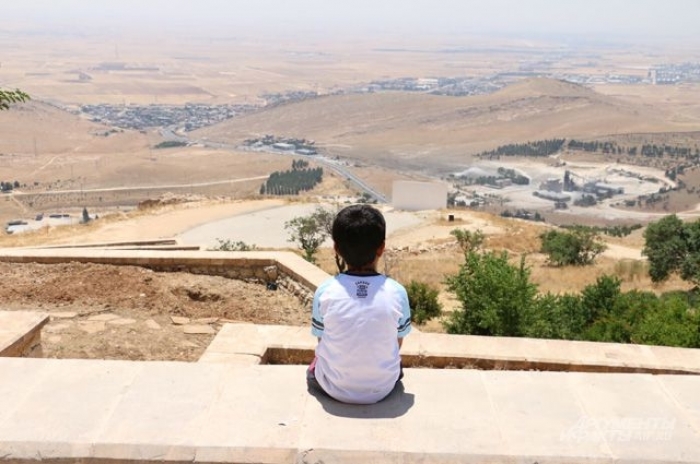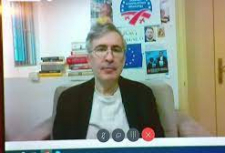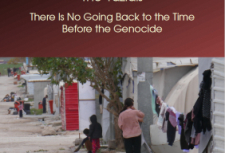Religious Minorities in Kurdistan: Beyond the Mainstream : Current Changes in the Yazidi System of Transmission of Religious Knowledge and the Status of Spiritual Authority

Edited by Khanna Omarkhali
Yazidis are adherents of the non-proselytising pre-Islamic Kurdish religion which they call êzdiyatî or êzdîtî . Wherever Yazidis (self appellation êzdî ) live, they speak northern Kurdish dialect Kurmanji, in which almost all of their oral religious texts have been composed. Practically all Yazidis claim a Kurdish identity, while some Yazidis in the Caucasus claim to belong to the separate Yazidi ethnie and call their religion Şerfedîn . Throughout their history Yazidis have suffered greatly from religious persecution, and partly due to this they have become a closed religious community, which has also led to many untrue ac-counts about them being published in the literature.
According to unofficial estimates, the world-wide population of Yazidis is slightly above 550,000, i.e. 2.3% of the Kurdish population. They live mainly in Iraqi Kurdistan, Syria, Turkey, and Iran, but also in Armenia and Georgia, the majority of whom settled there in the beginning of the 20 th century after reli-gious oppression from the Ottoman Empire. From the 1980s, at least three mi-grations of Yazidis from the homeland(s) to different European countries took place: in 1980s migration from Turkey to Germany, in the late 1980s–1990s many Iraqi Yazidis went to Europe, and in ca. 1990 there was a massive migra-tion from Armenia and Georgia to the Russian Federation, the Ukraine and Europe. The Yazidis now also live in France, Belgium, the Netherlands and the United States of America. The only centre of the religion and its ceremonial rituals, Lalish, is located in Iraqi Kurdistan, in the Sheikhan region. According to Yezidi religious literature, Lalish was sent by God from heaven to the place where He first created the foundation of the Earth. It is in Lalish, where the tomb of Sheikh ʿAdī (see below), the place of Yezdi pilgrimage, is located.
In Yazidism one can find a number of elements inherent in other religions, and also some extraneous features, while the cosmogony, dogma and many ritu-als go back to the ancient Indo-Iranian religious substratum. Sheikh ʿAdī ibn Musāfir (1073/8–1162), who was born in the village Beit Far in the Bekaa valley south of Baalbek, studied in Baghdad with ʿAbd al-Qādir AL -J ĪLĀNĪ (Pers. G ĪLĀNĪ ), and died in Lalish, played an important role in the history of Yazidism in the 12th century. His followers were commonly known as ʿAdawī s. The ʿAdawī order acquired new life in Lalish from Ḥasan ibn ʿAdī (b. 1195). Some Yazidi tribes are cited in the historical chronicles as rulers with a sphere of influence stretching into what is now Syria and Turkey.
Yazidis believe in one God, whom they refer to as Xwedê , Êzdan , and, less commonly, Heq (Ar. Ḥaqq ). In accordance with Yezidism, fire, water, air and the earth are sacred elements that are not be polluted. During prayer a Yazidi faces towards the sun, for which they were often called “sun worshipers”. The Yazidi myth of Creation begins with the description of the emptiness and the absence of order in the Universe. Prior to the Creation of the World God created a white pearl (Kurd. dur ) in the spiritual form from his own pure Light and alone dwelt in it. First there was an esoteric world, and after that an exoteric world was created. Before the creation of this world God created seven Divine Beings (often called “angels” in the literature), the leader of whom was appointed Tawusî Melek (Peacock Angel). God assigned all the world’s affairs to the seven Divine Beings. The end of Creation is closely connected with the Creator loosening direct ties from the Universe’s affairs, His creation of mankind and the transition from mythological to historical time. Yazidis believe in metempsychosis, which plays an exceptional role in Yazidi religiosity and is called ‘change of [one’s] shirt’ (Kurd. kiras gorîn ). There is also a belief that some of the events from the time of Creation repeat themselves in cycles of history. In Yazidism, different concepts of time coexist: an esoteric time sphere (Kurd. enzel ); a cyclic course of time (Kurd. bedîl or dewr ); a linear course, which runs from the start of the creation by God to the collective eschatological end point; and three ‘storms’ (Kurd. tofan ) which divide the history of Yazidism into four stages. In Yazidism, the older original concept of metempsychosis and the cyclic perception of the course of time is harmonized and coexists with the younger idea of a collective eschatology. 4 The structure of Yazidi society probably underwent the most fundamental transformation in the 12 th century during the time of Sheikh ʿAdī ibn Musāfir. There are three hereditary groups (castes) in Yazidism; two of them are clergies, the pîr s and the şêx s, and about 95% are laymen, the mirîd s. A Yazidi belongs to a caste by birth; both parents should be descended from the same group. Changing caste in accordance with the individual’s wishes is impossible. All boys pass through the rites of passage regardless of which caste each boy belongs to. There is a strict endogamy in Yazidism: marriages between castes are forbidden. Marriages in the Sheikh caste are possible only between representatives of each of three clans: Adanî, Şemsanî and Qatanî. Marriages in the pîr caste are possible between each other, with the exception of pîr s of the Hesmeman clan.
The Yazidi caste endogamy has become a big obstacle for young Yazidis in Diaspora. The secular and religious head of all Yezidis is the mīr , who descends from the Sheikh’s clan of Şêxûbekir and lives in Iraqi Kurdistan. The Yezidi priesthood hierarchy in Lalish also includes Baba Şêx , Pêşîmam , Baba Çawûş , Micêwir , Feqra , and others. All members of the Yezidi community, according to pênc ferz (Kurd. lit. “five duties”), must have their own pîr , şêx , hosta , merebî and birê/xûşka axiretê (“brother/sister of hereafter”), 7 who are responsible for their spiritual life and development. Nowadays the status and functions of hosta and merebî are less clearly defined.
II. The system of transmission of religious knowledge
The Yazidi community is characterized by strong cultural, religious and social traditions in which religious knowledge, as in various other traditional societies, is organised in hierarchical chains through which authority is legitimated by custom. The hypothesis underlying the paper is that changes in Yazidi society caused by a number of migration waves, globalization, individualization and the role of media have led to new forms of transmission of religious knowledge and a new understanding or re-comprehension of spiritual authority among Yazidis. Yazidi religious oral tradition is handed down in practices, religious values, etc. that are considered by all Yazidis as ‘old’, fundamental and valued infor-mation for the community, and shared by everyone in the society. Although the Yazidi religious oral tradition is perceived as being property of every member of the community, it has been preserved and handed down over generations orally and through the means of verbal art by a special group of individuals who have learned the texts, as well as their performance and their meaning, from their ancestors, and kept them alive in their memories and performed them among the Yazidis. This group of experts includes qewlbêj s (Kurd. ‘the reciters of the religious texts’), qewal s, and some male representatives of the priestly families (i.e., pîr s and şêx s), who not only reproduce the knowledge they have heard and gleaned from the older generation, but also act as the bearers of religious know-ledge and cultural memory. In the Yazidi community there have always been reciters of diverse levels who have memorized a certain number of compositions.
The training of a reciter of religious hymns continues throughout a per- son’s entire lifetime through both passive and active learning processes. A good expert of religious knowledge never stops learning; instead, he preserves the knowledge through daily repetition both during religious feasts and on his own, and also enriches his repertoire by memorization of new for him texts during planned or spontaneous meetings with other masters.
The traditional relationship between pupil and teacher could be described as the relationship between reciter and the entire Yazidi tradition, which the reciter finds in the form of specific individual performances. He then learns it, reproduces it, and at some point becomes a teacher himself. A Yazidi qewlbêj not only learns from the common Yazidi store or treasure house built up by the individuals who have come before him, but becomes a part of this storehouse himself afterwards by orally transmitting Yazidi religious knowledge. The Yezidi system of transmission of religious knowledge is currently under-going crucial changes in response to technical advances and the increasing circulation of religious written literature. Writing and media culture have come to play a role in the daily life of Yazidis both in their homeland and in Diaspora, and this shows an increasing influence on the Yazidi oral tradition. Yazidis have started scriptural zing the sacred oral tradition, which has led to the raising of the question of canonization of the oral religious texts, which is a new stage in development of Yszidism, namely transition to a written tradition. 15 The role of spiritual master (Kurd. hosta ) in the training of reciters of religious hymns (Kurd. qewlbêj ) was vital to the transmission of the sacred know-ledge that is conveyed orally and ritualistically. The significant characteristic of such relationships based on oral tradition was the personal contact between spiritual master and disciple. The personal authority of a spiritual leader was (and still is) the crucial one for the Yazidi tradition. In Yazidi society we can now observe different ways of transmitting religious knowledge, whereby one system does not exclude the other, and they coexist. For instance, transmission of the texts verbatim from a preceptor to a pupil coexists with learning from written, published or recorded texts. We are now witnessing, however, an artificial renaissance of the tradition, where young Yazidis learn the texts from printed collections and the authority of the spiritual master is replaced by that of printed works.
Yazidis.info
Tags:
Religious Minorities in Kurdistan: Beyond the Mainstream : Current Changes in the Yazidi System of Transmission of Religious Knowledge and the Status of Spiritual Authority

Edited by Khanna Omarkhali
Yazidis are adherents of the non-proselytising pre-Islamic Kurdish religion which they call êzdiyatî or êzdîtî . Wherever Yazidis (self appellation êzdî ) live, they speak northern Kurdish dialect Kurmanji, in which almost all of their oral religious texts have been composed. Practically all Yazidis claim a Kurdish identity, while some Yazidis in the Caucasus claim to belong to the separate Yazidi ethnie and call their religion Şerfedîn . Throughout their history Yazidis have suffered greatly from religious persecution, and partly due to this they have become a closed religious community, which has also led to many untrue ac-counts about them being published in the literature.
According to unofficial estimates, the world-wide population of Yazidis is slightly above 550,000, i.e. 2.3% of the Kurdish population. They live mainly in Iraqi Kurdistan, Syria, Turkey, and Iran, but also in Armenia and Georgia, the majority of whom settled there in the beginning of the 20 th century after reli-gious oppression from the Ottoman Empire. From the 1980s, at least three mi-grations of Yazidis from the homeland(s) to different European countries took place: in 1980s migration from Turkey to Germany, in the late 1980s–1990s many Iraqi Yazidis went to Europe, and in ca. 1990 there was a massive migra-tion from Armenia and Georgia to the Russian Federation, the Ukraine and Europe. The Yazidis now also live in France, Belgium, the Netherlands and the United States of America. The only centre of the religion and its ceremonial rituals, Lalish, is located in Iraqi Kurdistan, in the Sheikhan region. According to Yezidi religious literature, Lalish was sent by God from heaven to the place where He first created the foundation of the Earth. It is in Lalish, where the tomb of Sheikh ʿAdī (see below), the place of Yezdi pilgrimage, is located.
In Yazidism one can find a number of elements inherent in other religions, and also some extraneous features, while the cosmogony, dogma and many ritu-als go back to the ancient Indo-Iranian religious substratum. Sheikh ʿAdī ibn Musāfir (1073/8–1162), who was born in the village Beit Far in the Bekaa valley south of Baalbek, studied in Baghdad with ʿAbd al-Qādir AL -J ĪLĀNĪ (Pers. G ĪLĀNĪ ), and died in Lalish, played an important role in the history of Yazidism in the 12th century. His followers were commonly known as ʿAdawī s. The ʿAdawī order acquired new life in Lalish from Ḥasan ibn ʿAdī (b. 1195). Some Yazidi tribes are cited in the historical chronicles as rulers with a sphere of influence stretching into what is now Syria and Turkey.
Yazidis believe in one God, whom they refer to as Xwedê , Êzdan , and, less commonly, Heq (Ar. Ḥaqq ). In accordance with Yezidism, fire, water, air and the earth are sacred elements that are not be polluted. During prayer a Yazidi faces towards the sun, for which they were often called “sun worshipers”. The Yazidi myth of Creation begins with the description of the emptiness and the absence of order in the Universe. Prior to the Creation of the World God created a white pearl (Kurd. dur ) in the spiritual form from his own pure Light and alone dwelt in it. First there was an esoteric world, and after that an exoteric world was created. Before the creation of this world God created seven Divine Beings (often called “angels” in the literature), the leader of whom was appointed Tawusî Melek (Peacock Angel). God assigned all the world’s affairs to the seven Divine Beings. The end of Creation is closely connected with the Creator loosening direct ties from the Universe’s affairs, His creation of mankind and the transition from mythological to historical time. Yazidis believe in metempsychosis, which plays an exceptional role in Yazidi religiosity and is called ‘change of [one’s] shirt’ (Kurd. kiras gorîn ). There is also a belief that some of the events from the time of Creation repeat themselves in cycles of history. In Yazidism, different concepts of time coexist: an esoteric time sphere (Kurd. enzel ); a cyclic course of time (Kurd. bedîl or dewr ); a linear course, which runs from the start of the creation by God to the collective eschatological end point; and three ‘storms’ (Kurd. tofan ) which divide the history of Yazidism into four stages. In Yazidism, the older original concept of metempsychosis and the cyclic perception of the course of time is harmonized and coexists with the younger idea of a collective eschatology. 4 The structure of Yazidi society probably underwent the most fundamental transformation in the 12 th century during the time of Sheikh ʿAdī ibn Musāfir. There are three hereditary groups (castes) in Yazidism; two of them are clergies, the pîr s and the şêx s, and about 95% are laymen, the mirîd s. A Yazidi belongs to a caste by birth; both parents should be descended from the same group. Changing caste in accordance with the individual’s wishes is impossible. All boys pass through the rites of passage regardless of which caste each boy belongs to. There is a strict endogamy in Yazidism: marriages between castes are forbidden. Marriages in the Sheikh caste are possible only between representatives of each of three clans: Adanî, Şemsanî and Qatanî. Marriages in the pîr caste are possible between each other, with the exception of pîr s of the Hesmeman clan.
The Yazidi caste endogamy has become a big obstacle for young Yazidis in Diaspora. The secular and religious head of all Yezidis is the mīr , who descends from the Sheikh’s clan of Şêxûbekir and lives in Iraqi Kurdistan. The Yezidi priesthood hierarchy in Lalish also includes Baba Şêx , Pêşîmam , Baba Çawûş , Micêwir , Feqra , and others. All members of the Yezidi community, according to pênc ferz (Kurd. lit. “five duties”), must have their own pîr , şêx , hosta , merebî and birê/xûşka axiretê (“brother/sister of hereafter”), 7 who are responsible for their spiritual life and development. Nowadays the status and functions of hosta and merebî are less clearly defined.
II. The system of transmission of religious knowledge
The Yazidi community is characterized by strong cultural, religious and social traditions in which religious knowledge, as in various other traditional societies, is organised in hierarchical chains through which authority is legitimated by custom. The hypothesis underlying the paper is that changes in Yazidi society caused by a number of migration waves, globalization, individualization and the role of media have led to new forms of transmission of religious knowledge and a new understanding or re-comprehension of spiritual authority among Yazidis. Yazidi religious oral tradition is handed down in practices, religious values, etc. that are considered by all Yazidis as ‘old’, fundamental and valued infor-mation for the community, and shared by everyone in the society. Although the Yazidi religious oral tradition is perceived as being property of every member of the community, it has been preserved and handed down over generations orally and through the means of verbal art by a special group of individuals who have learned the texts, as well as their performance and their meaning, from their ancestors, and kept them alive in their memories and performed them among the Yazidis. This group of experts includes qewlbêj s (Kurd. ‘the reciters of the religious texts’), qewal s, and some male representatives of the priestly families (i.e., pîr s and şêx s), who not only reproduce the knowledge they have heard and gleaned from the older generation, but also act as the bearers of religious know-ledge and cultural memory. In the Yazidi community there have always been reciters of diverse levels who have memorized a certain number of compositions.
The training of a reciter of religious hymns continues throughout a per- son’s entire lifetime through both passive and active learning processes. A good expert of religious knowledge never stops learning; instead, he preserves the knowledge through daily repetition both during religious feasts and on his own, and also enriches his repertoire by memorization of new for him texts during planned or spontaneous meetings with other masters.
The traditional relationship between pupil and teacher could be described as the relationship between reciter and the entire Yazidi tradition, which the reciter finds in the form of specific individual performances. He then learns it, reproduces it, and at some point becomes a teacher himself. A Yazidi qewlbêj not only learns from the common Yazidi store or treasure house built up by the individuals who have come before him, but becomes a part of this storehouse himself afterwards by orally transmitting Yazidi religious knowledge. The Yezidi system of transmission of religious knowledge is currently under-going crucial changes in response to technical advances and the increasing circulation of religious written literature. Writing and media culture have come to play a role in the daily life of Yazidis both in their homeland and in Diaspora, and this shows an increasing influence on the Yazidi oral tradition. Yazidis have started scriptural zing the sacred oral tradition, which has led to the raising of the question of canonization of the oral religious texts, which is a new stage in development of Yszidism, namely transition to a written tradition. 15 The role of spiritual master (Kurd. hosta ) in the training of reciters of religious hymns (Kurd. qewlbêj ) was vital to the transmission of the sacred know-ledge that is conveyed orally and ritualistically. The significant characteristic of such relationships based on oral tradition was the personal contact between spiritual master and disciple. The personal authority of a spiritual leader was (and still is) the crucial one for the Yazidi tradition. In Yazidi society we can now observe different ways of transmitting religious knowledge, whereby one system does not exclude the other, and they coexist. For instance, transmission of the texts verbatim from a preceptor to a pupil coexists with learning from written, published or recorded texts. We are now witnessing, however, an artificial renaissance of the tradition, where young Yazidis learn the texts from printed collections and the authority of the spiritual master is replaced by that of printed works.
Yazidis.info
Tags:


























